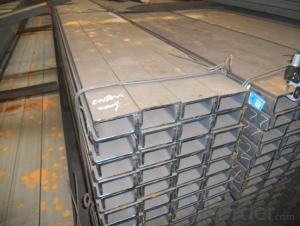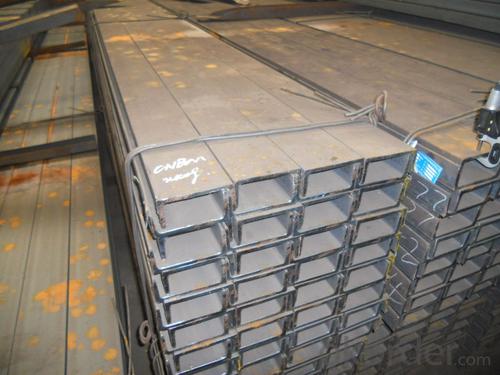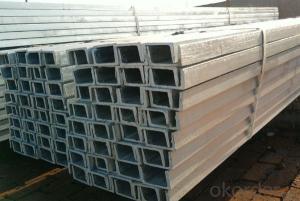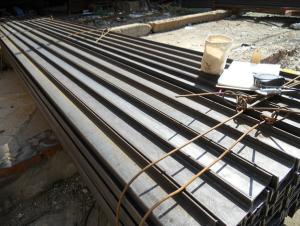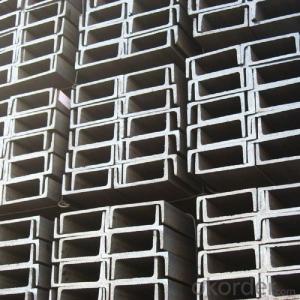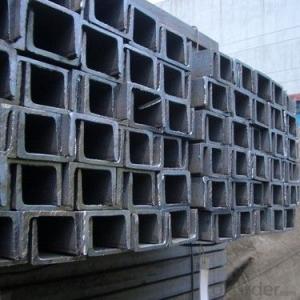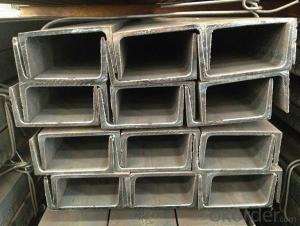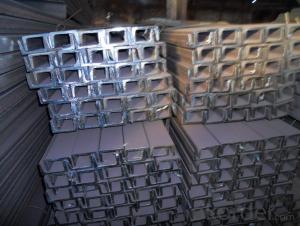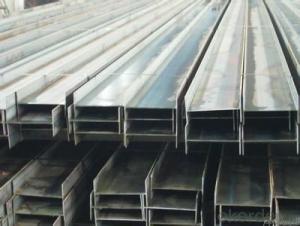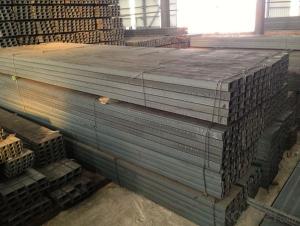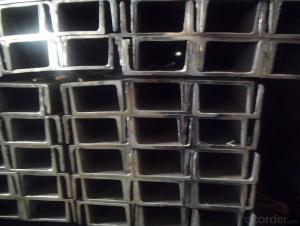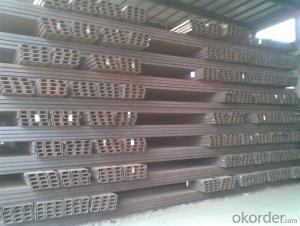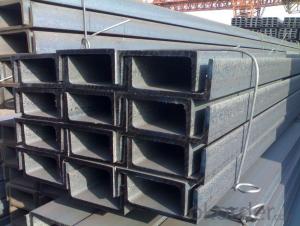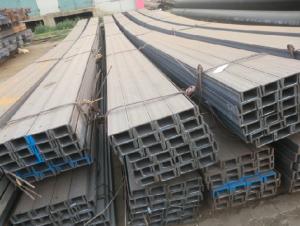Hot Rolled Steel U Channek beams for Construction of Warehouses
- Loading Port:
- Tianjin
- Payment Terms:
- TT OR LC
- Min Order Qty:
- 25 m.t.
- Supply Capability:
- 200000 m.t./month
OKorder Service Pledge
OKorder Financial Service
You Might Also Like
Product Description:
OKorder is offering Hot Rolled Steel U Channek beams for Construction of Warehouses at great prices with worldwide shipping. Our supplier is a world-class manufacturer of steel, with our products utilized the world over. OKorder annually supplies products to European, North American and Asian markets. We provide quotations within 24 hours of receiving an inquiry and guarantee competitive prices.
Product Applications:
Hot Rolled Steel U Channek beams for Construction of Warehouses are ideal for structural applications and general fabricating. The steel u channel can be applied to construction of warehouses, workshops, sport stadiums and car parks etc. In details, the steel u channel belongs to carbon structural steel which is applied to in the field of construction and machinery. The steel u channel is usually used for arch-itechtural structure, and they could be welded in order to support or hang a vari-ety of facilities. They are also usually used in combination with I beam. Generally,the steel u channel must possess perfect welding property, riveting property and mechanical property and so on.
Product Advantages:
Hot Rolled Steel U Channek beams for Construction of Warehouses are durable, strong, and resists corrosion.
Main Product Features:
· Premium quality
· Prompt delivery & seaworthy packing (7-10 days after receiving deposit)
· Corrosion resistance
· Can be recycled and reused
· Mill test certification
· Professional Service
· Competitive pricing
Product Specifications:
Hot Rolled Steel U Channek beams for Construction of Warehouses Details:
Minimum Order Quantity: 25 Tons Unit: m.t. Loading Port: Xingang Port
Supply Ability: 1000 Tons Per Day Payment Terms: TT or L/C
Product Description:
Specifications of Steel U Channel:
Standard Applied: GB Standard, EN Standard(UPN), JIS Standard
Sizes: 50mm to 300mm
Material Grade: Q235B, Q345B, S235JR, SS400, ASTM A36
As shown in the figure:
| JIS U CHANNEL | Standard h | Sectional b | Dimension s | t | Mass: Kg/m |
| (mm) | (mm) | (mm) | (mm) | ||
| 50x25 | 50 | 25 | 3.0 | 6.00 | 2.37 |
| 75X40 | 75 | 40 | 3.8 | 7.00 | 5.30 |
| 75X40 | 75 | 40 | 4.0 | 7.00 | 5.60 |
| 75X40 | 75 | 40 | 4.5 | 7.00 | 5.85 |
| 75X40 | 75 | 40 | 5.0 | 7.00 | 6.92 |
| 100X50 | 100 | 50 | 3.8 | 6.00 | 7.30 |
| 100X50 | 100 | 50 | 4.2 | 6.00 | 8.03 |
| 100X50 | 100 | 50 | 4.5 | 7.50 | 8.97 |
| 100X50 | 100 | 50 | 5.0 | 7.50 | 9.36 |
| 125X65 | 125 | 65 | 5.2 | 6.80 | 11.66 |
| 125X65 | 125 | 65 | 5.3 | 6.80 | 12.17 |
| 125X65 | 125 | 65 | 5.5 | 8.00 | 12.91 |
| 125X65 | 125 | 65 | 6.0 | 8.00 | 13.40 |
| 150x75 | 150 | 75 | 5.5 | 7.30 | 14.66 |
| 150x75 | 150 | 75 | 5.7 | 10.00 | 16.71 |
| 150x75 | 150 | 75 | 6.0 | 10.00 | 17.90 |
| 150x75 | 150 | 75 | 6.5 | 10.00 | 18.60 |
FAQ:
Q1: Can Hot Rolled Steel U Channek beams for Construction of Warehouses rust?
A1: Hot Rolled Steel U Channek beams for Construction of Warehouses do not "rust" as you think of regular steel rusting with a red oxide on the surface that flakes off. If you see red rust it is probably due to some iron particles that have contaminated the surface of the stainless steel and it is these iron particles that are rusting. Look at the source of the rusting and see if you can remove it from the surface.
Q2: What is the normal tolerance of Hot Rolled Steel U Channek beams for Construction of Warehouses?
A2: Normally 3%-5%, but we can also produce the goods according to the customers' requests
Q3: The products are invoicing on theoritical weight or on actual weight?
A3: We can do it in both manners, according to the customers' request.
duce the goods according to the customers' requests
- Q: How do you calculate the deflection of steel channels?
- To calculate the deflection of steel channels, you need to consider various factors such as the material properties, dimensions, loading conditions, and support conditions. The deflection of a steel channel can be determined using the principles of structural mechanics and beam theory. Here is a step-by-step process to calculate the deflection: 1. Determine the material properties: Obtain the modulus of elasticity (E) and the moment of inertia (I) of the steel channel. These values can be obtained from material specifications or reference manuals. 2. Determine the dimensions: Measure or obtain the dimensions of the steel channel, including the height (h), width (b), and thickness (t). These measurements are necessary to calculate the moment of inertia. 3. Determine the loading conditions: Identify the applied loads, such as point loads, distributed loads, or moments, acting on the steel channel. Determine the magnitude and location of these loads. 4. Identify the support conditions: Determine whether the steel channel is simply supported, fixed at both ends, or has other support conditions. This information is critical to determine the appropriate boundary conditions for the deflection calculation. 5. Determine the type of beam equation to use: Based on the loading and support conditions, select the appropriate beam equation to calculate the deflection. Common equations include the Euler-Bernoulli beam equation or the Timoshenko beam equation. 6. Apply the beam equation: Substitute the appropriate values into the selected beam equation. This equation relates the deflection (δ) to the applied loads, material properties, and dimensions of the steel channel. 7. Solve the beam equation: Depending on the complexity of the loading and support conditions, you may need to solve the beam equation analytically, numerically, or using software tools. Analytical solutions are available for simple loading and support conditions, while numerical methods or software tools may be necessary for more complex scenarios. 8. Calculate the deflection: Once you have solved the beam equation, you can calculate the deflection of the steel channel at specific points or along its entire length. The deflection is typically measured in units of length (e.g., inches or millimeters). It is important to note that calculating the deflection of steel channels is a complex process, and it is recommended to consult relevant engineering codes, standards, or reference materials for detailed equations and procedures specific to your application. Additionally, consider seeking assistance from a qualified structural engineer for accurate and reliable results.
- Q: How do steel channels contribute to the overall sustainability certifications of a project?
- Steel channels contribute to the overall sustainability certifications of a project in several ways. Firstly, steel channels are highly durable and have a long lifespan, which reduces the need for frequent replacements and repairs. This not only saves resources but also minimizes waste generation throughout the project's lifecycle. Additionally, steel channels are often made from recycled materials, which further decreases the demand for virgin resources and reduces the carbon footprint associated with their production. The use of recycled steel channels also helps divert waste from landfills, contributing to waste reduction goals and promoting a circular economy. Furthermore, steel channels are highly recyclable at the end of their life, allowing for their reuse in other projects. This reduces the demand for new steel production and conserves energy and resources that would have been required for manufacturing new channels. Moreover, steel's strength and load-bearing capacity make it an excellent material for structural applications, enabling the construction of more efficient and sustainable buildings. Steel channels can support larger spans and higher loads, which allows for the use of lighter and more sustainable building materials in other areas of the project. Lastly, steel channels can contribute to a project's sustainability certifications by enabling the design and construction of energy-efficient structures. They can be incorporated into innovative building systems, such as passive solar design or efficient HVAC systems, which can reduce energy consumption and greenhouse gas emissions associated with the project. In summary, steel channels contribute to the overall sustainability certifications of a project by providing durability, utilizing recycled materials, promoting recycling at the end of life, enabling efficient designs, and supporting energy-efficient construction practices.
- Q: How do steel channels contribute to earthquake-resistant structures?
- Steel channels contribute to earthquake-resistant structures by providing strength and stability. They are used as structural members to distribute and resist the seismic forces generated during an earthquake. The channels are strategically placed and interconnected to create a rigid framework that can absorb and dissipate the energy produced by seismic waves. This helps prevent the collapse of the building and ensures the safety of its occupants. Additionally, steel channels offer flexibility, allowing the structure to undergo some degree of deformation without losing its integrity, further enhancing its earthquake resistance.
- Q: How do steel channels contribute to the overall energy efficiency of a structure?
- Steel channels contribute to the overall energy efficiency of a structure in several ways. Firstly, they provide excellent structural support, allowing for the construction of larger and more open spaces, which can maximize natural light and ventilation, reducing the need for artificial lighting and air conditioning. Additionally, steel channels have high thermal conductivity, allowing them to efficiently transfer heat or cold throughout the structure, helping to maintain a comfortable indoor temperature without excessive reliance on heating or cooling systems. Finally, steel channels have a high strength-to-weight ratio, meaning they require less material to achieve the same level of structural integrity, resulting in a lighter and more energy-efficient overall construction.
- Q: What are the different types of clamps used for steel channels?
- There are several different types of clamps used for steel channels, including beam clamps, channel clamps, strut clamps, pipe clamps, and C-clamps. Each type of clamp is designed to securely hold steel channels in place and provide support for various applications.
- Q: Are steel channels suitable for seismic zones?
- Yes, steel channels are suitable for seismic zones. Steel is a strong and ductile material that can effectively resist seismic forces. Steel channels are commonly used in seismic design and construction due to their ability to provide structural stability and resilience during earthquakes. They offer excellent strength-to-weight ratio, flexibility, and resistance to bending and shearing forces, making them a reliable choice for seismic zone applications.
- Q: What's the size of channel 16, please? Thank you!
- 16A - H height 160mm, B leg width 63mm, D waist thickness 6.5mm - sectional area 21.962/ square cm, weight 17.240kg/m16b - H height 160mm, B leg width 65mm, D waist thickness 8.5mm - sectional area 25.162/ square cm, weight 19.752kg/m
- Q: How do steel channels contribute to the overall acoustics of a building?
- The overall acoustics of a building can be significantly affected by steel channels. These channels are commonly used as structural components in the construction of walls, ceilings, and floors. The manner in which these channels are installed and connected in a building can impact the way sound travels through the space. One way in which steel channels impact the acoustics of a building is by offering a rigid structure that aids in controlling sound transmission. When installed correctly, steel channels can decrease the transfer of sound vibrations between different areas of the building. This is particularly important in spaces where privacy and noise control are crucial, such as offices, conference rooms, or residential units. Furthermore, steel channels can be utilized to establish acoustic isolation between different rooms or floors. By suspending ceilings or creating floating floors using steel channels, vibrations and impact noise can be minimized. This is especially vital in spaces where activities such as music recording, theaters, or classrooms take place, as it assists in preventing unwanted noise from traveling between rooms. Additionally, steel channels can enhance the sound quality within a space by providing a sturdy mounting surface for acoustical treatments such as sound-absorbing panels, diffusers, or bass traps. These treatments can be strategically positioned on the steel channels to enhance the overall clarity and balance of sound within a room, reducing echoes and reverberations. In conclusion, steel channels play a critical role in the overall acoustics of a building by controlling sound transmission, providing acoustic isolation, and allowing for the integration of acoustical treatments. Proper utilization of steel channels during the construction process can help create a comfortable, functional, and acoustically optimized environment for various applications.
- Q: How do steel channels perform in corrosive environments?
- The durability and strength of steel channels are widely recognized, but their performance in corrosive environments can vary depending on the type of steel used and the severity of the conditions. In general, steel channels resist corrosion due to the formation of a protective oxide layer when exposed to oxygen in the air. This layer acts as a barrier, preventing further oxidation and protecting the steel. However, exposure to corrosive environments like saltwater or industrial chemicals can compromise this protective layer, leading to potential corrosion. To enhance the performance of steel channels in corrosive environments, corrosion-resistant alloys or coatings can be used. Stainless steel channels, for instance, contain chromium and other elements that offer excellent corrosion resistance. These channels are highly resistant to rust and can withstand even the most challenging conditions. In more severe corrosive conditions, additional protective measures like galvanizing or epoxy coatings can be applied. Galvanizing involves coating the steel with a layer of zinc, which acts as a sacrificial anode, protecting the underlying steel. Epoxy coatings create a barrier between the steel and the corrosive environment, minimizing the risk of corrosion. It's important to note that despite these protective measures, steel channels may still experience corrosion over time, especially without proper maintenance. Regular inspection, cleaning, and maintenance can help identify and address any signs of corrosion early on, extending the lifespan and performance of the steel channels in corrosive environments. Overall, while steel channels can perform well in corrosive environments, it's crucial to consider the specific conditions and choose the appropriate type of steel, coatings, or alloys to ensure optimal performance and longevity.
- Q: Are steel channels suitable for swimming pool installations?
- Swimming pool installations do not lend themselves well to steel channels. Usually utilized for structural support or as a framework for substantial constructions such as bridges or buildings, steel channels lack the necessary qualities for swimming pool installations. In contrast, concrete or fiberglass materials are commonly employed due to their resilience, waterproof characteristics, and capacity to endure continuous contact with water and chemicals. Specifically engineered for swimming pool installations, these materials guarantee a dependable and enduring solution.
Send your message to us
Hot Rolled Steel U Channek beams for Construction of Warehouses
- Loading Port:
- Tianjin
- Payment Terms:
- TT OR LC
- Min Order Qty:
- 25 m.t.
- Supply Capability:
- 200000 m.t./month
OKorder Service Pledge
OKorder Financial Service
Similar products
Hot products
Hot Searches
Related keywords
